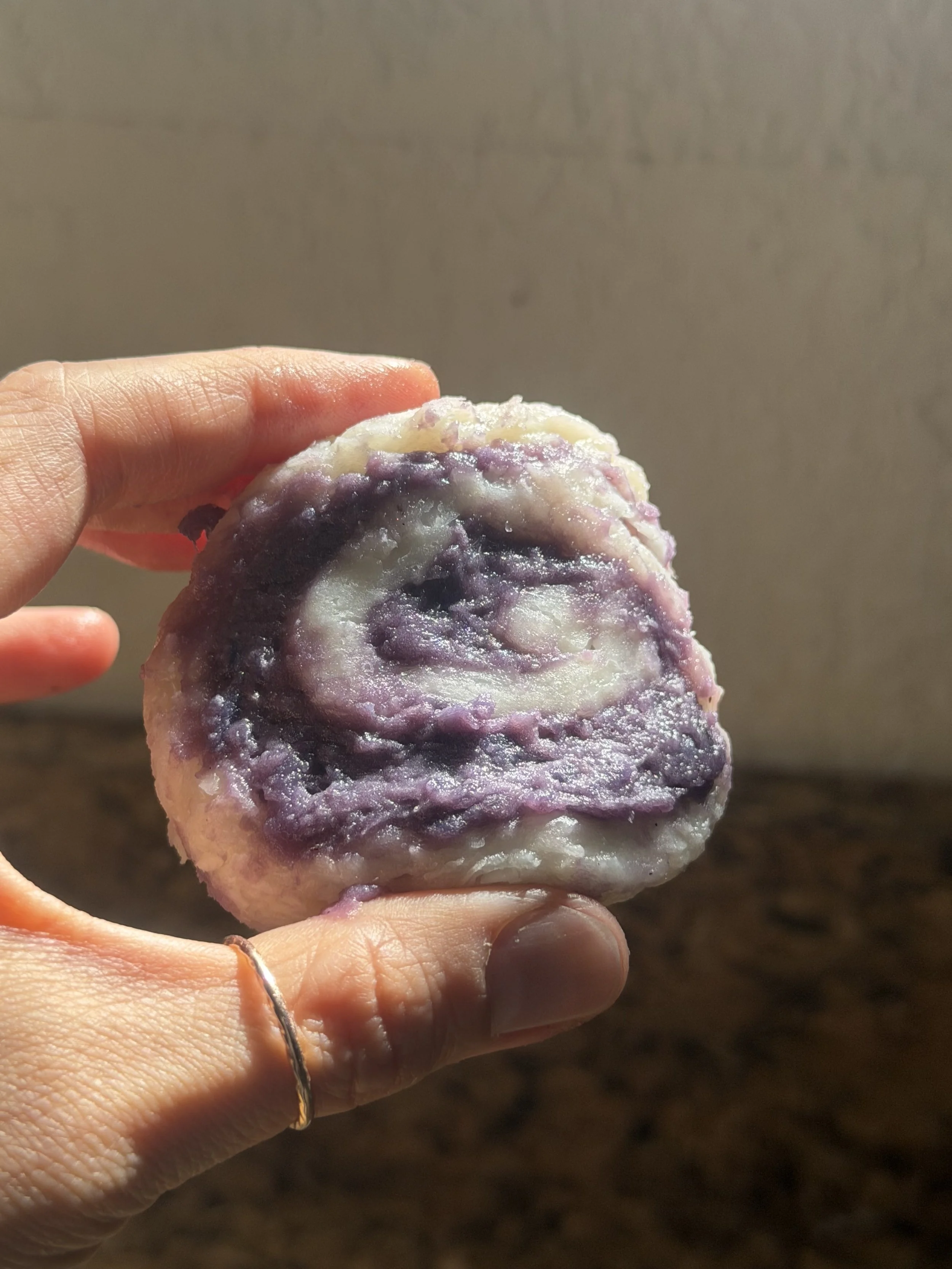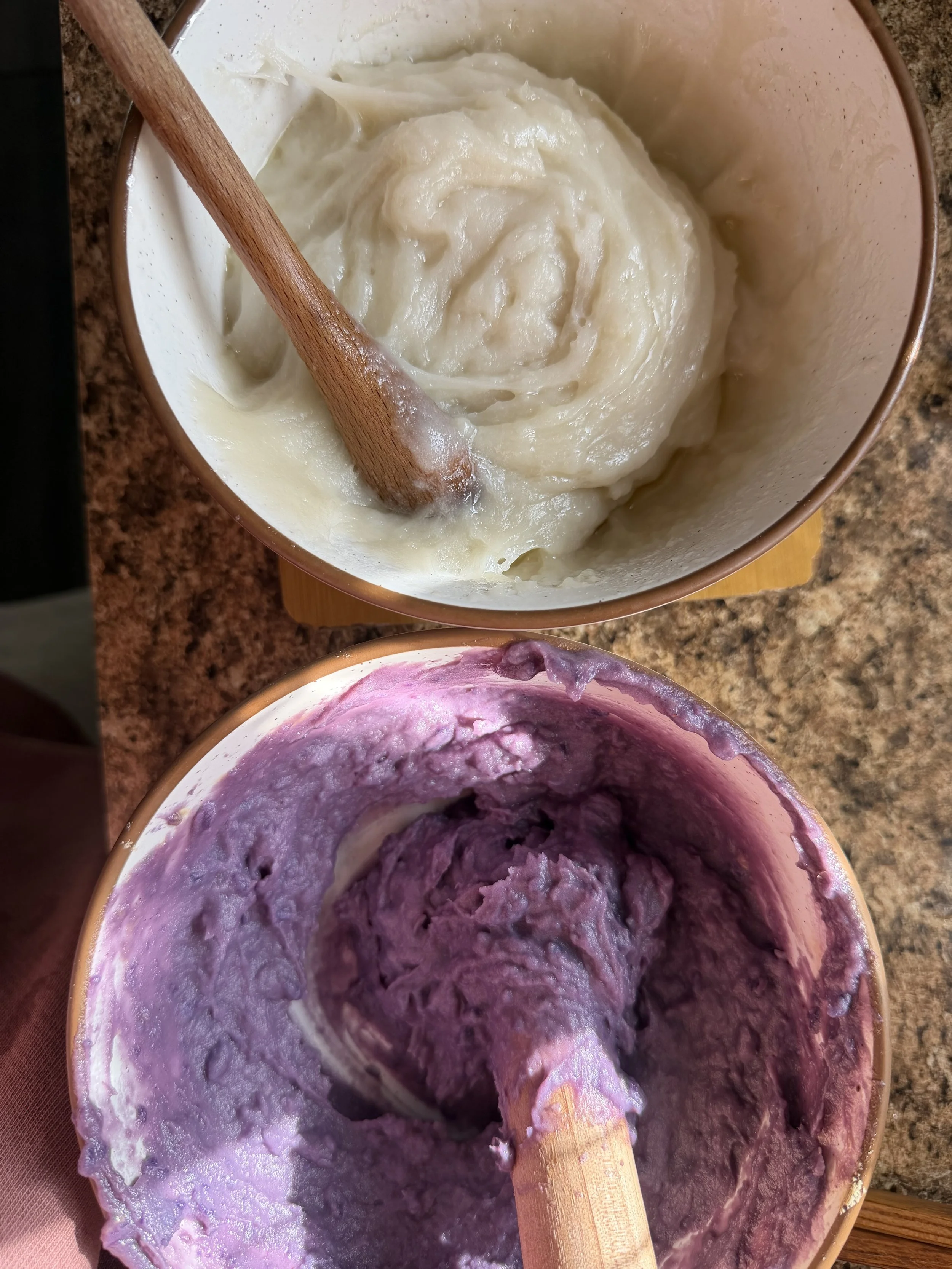Gut-Nourishing Purple Sweet Potato Mochi Roll
This gut-nourishing Purple Sweet Potato Mochi Roll is naturally gluten-free, refined sugar-free, and filled with antioxidant-rich purple sweet potato. A soothing, anti-inflammatory treat perfect for digestion and eczema-prone kids—soft, chewy, and sweetened only by whole foods.
Soft, chewy mochi filled with creamy purple sweet-potato goodness—made with only whole-food ingredients. As always with gut health, skin health, eczema and sensitive stomachs in mind.
INGREDIENTS
For the Mochi Dough
1½ cups glutinous rice flour — 200g
(If making your own from organic rice, see below.)100% coconut milk — 180 ml
A splash of water as needed — 15ml
1 tbsp grass-fed tallow*
A pinch of sea salt
No sugar in the dough
(Optional: drizzle raw organic honey* on the slices after rolling.)
For the Filling
2 small purple sweet potato — approx. 250 g raw (about 200 g cooked/peeled)
1 scoop grass-fed Be Well By Kelly Vanilla Protein*
Splash of coconut milk (if needed)
For Dusting
Desiccated coconut (optional)
(If coconut-allergic: use lightly toasted glutinous rice flour.)
How to Make Glutinous Rice Flour From Scratch (Using Organic Rice)
While mochiko is convenient and traditionally made from glutinous (sticky) rice, you can create a similar flour at home to ensure it is easy to digest & lower in arsenic / pesticides:
Measure 1½ cups organic sushi rice (this yields roughly the same amount of flour).
Soak & Sour for 4-6 hours. (Steps are here)
Rinse and drain well.
Spread the rice on an organic cotton cloth and let it air-dry completely.
Grind in a high-speed blender until it becomes an ultra-fine flour.
Sift to remove any coarse grains.
Note: Sushi rice won’t be as sticky as true glutinous rice, so your mochi will be slightly less stretchy. Still nutritious, delicious, and a bit firmer.
METHOD
1. Prepare the Purple Sweet Potato Filling
Steam the sweet potato in a double steaming pot, for 30 min, until completely mashable.
Peel and mash the potato until smooth.
Mix in scoop of Be Well By Kelly Grass-Fed Vanilla Protein* — adds a touch of sweetness via the ground up organic monkfruit + gut-healing support via naturally occurring collagen!
If the sweet potato mash feels dry, add a small splash of coconut milk.
Set aside to cool.
2. Make the Mochi Dough
In a heat-safe bowl, whisk together:
1½ cups glutinous rice flour
180 ml coconut milk
pinch of salt
The mixture will be thick and sticky.
Cover the bowl with covered with non-toxic parchment paper
Place in your double-steam setup and steam for 30 minutes, or until the dough is shiny, translucent, and bouncy when pressed.
Carefully remove from the steamer. Let it cool just enough to handle.
3. Knead & Shape the Dough
Oil your hands & work station well.
Melt tallow into the dough while it’s warm.
Stretch the warm mochi, fold it, press, knead and stretch again.
Repeat until it forms a soft, smooth dough ball.
4. Roll & Fill
Dust your work surface/parchment paper generously with desiccated coconut
(coconut-free option: use rice flour).Spread & roll the dough into a rectangle about 1/8 inch thick.
Starting from the edge, roll tightly into a log.
Use parchment paper to further tighten the log.
5. Slice & Serve
Use unflavored, plastic free dental floss to slice clean pieces.
Serve immediately or refrigerate in airtight glass container up to 3 days.
My favorite way to reheat this is to air fry it at 350°F for 5 minutes the outside gets perfectly crispy and the inside gets beautifully chewy again!
Optional: drizzle raw honey on each slice just before serving for a naturally sweet finish.
STORAGE
How to Store Your Purple Sweet Potato Mochi Roll
Mochi is at its softest on the day it’s made, but this roll keeps beautifully with the right care:
Room Temperature
Not recommended, as fresh sweet potato filling can soften too much and affect texture.
Refrigerator (best option)
Store the sliced mochi roll in an airtight glass container.
Best enjoyed within 2–3 days for optimal chewiness and freshness.
If the outer layer firms up slightly in the fridge, you can let it rest at room temp for 10–15 minutes before eating.
Freezer
Freezing is possible but not ideal—the texture becomes more brittle.
If you must freeze: wrap each slice individually and store for up to 1 month. Thaw in the fridge overnight.
*Ingredient Note & Discount
If you’d like to make this recipe exactly the way I do, the grass-fed vanilla protein, grass-fed/finished tallow and raw organic honey I use are all linked in the post.
Save when opting for these gut-friendly staples by using code MUMWITHABUN— a small yet impactful way to support gut health / those wanting the cleanest, most nourishing ingredients.
Purple Sweet Potato Mochi Swirl - A dessert that actually loves your gut.
Why this dessert is a “healing food”
1. Glutinous Rice Flour (especially if soaked/soured & if you make your own)
Naturally gluten-free and low gut irritant
Rich in prebiotic starches (resistant starch forms when cooled → supports gut bacteria and butyrate production)
Soaked/soured rice → reduced phytic acid, easier digestion, enhanced mineral availability
Provides steady, slow-burning carbs when paired with fats + protein
Healing benefit: gentle on digestion, supportive of gut bacteria, easy for sensitive tummies (kids + eczema-prone included).
2. 100% Coconut Milk
Contains MCTs → rapidly absorbed, supports mitochondrial energy, antimicrobial
Supports the gut lining with soothing fats
Stabilizes blood sugar when combined with carbs
Healing benefit: nourishes the gut lining and helps maintain hormonal and metabolic balance.
3. Grass-Fed & Finished Tallow
Rich in fat-soluble vitamins (A, D, K2)
Provides stable saturated fats that reduce blood sugar spikes
Anti-inflammatory profile when from a grass-fed source
Healing benefit: supports hormone regulation, skin barrier repair, and immune support!
4. Okinawa / Purple Sweet Potato Filling
High in anthocyanins → potent antioxidants for brain and skin health
Contains soluble fiber for digestion + microbiome health
Low glycemic when combined with fat/protein
Healing benefit: antioxidant-rich, gut-soothing, nutrient-dense carbohydrate.
5. Grass-Fed Protein Powder (Be Well By Kelly)
Adds complete protein to balance the carb content
Slows glucose absorption → keeps this dessert blood-sugar-friendly
Collagen-rich → supports gut wall repair (which is literally made of collagen) - so important for my eczema friends!
Chemical-free (this protein powder is extracted with heat & water only - like bone broth!)
Healing benefit: stabilizes blood sugar, supports gut repair, helps satiety.
6. Raw Honey (optional drizzle)
Contains vitamins, minerals, enzymes, polyphenols, and natural antimicrobials
Helps satisfy sweetness cravings while providing trace nutrients
Healing benefit: functional, whole-food sweetness — not to mention it’s time tested medicinal properties.
7. No Refined Sugar, No Additives, No Seed Oils
This is where the “healing dessert” concept comes to life.
By removing the major irritants (refined sugar + seed oils + gums + fillers), you find in most desserts (i.e. soy milk, refined sugar, etc) we eliminate the typical inflammatory dessert triggers and swapped them for gut health supporting ingredients. Our ancestors would be so proud.





